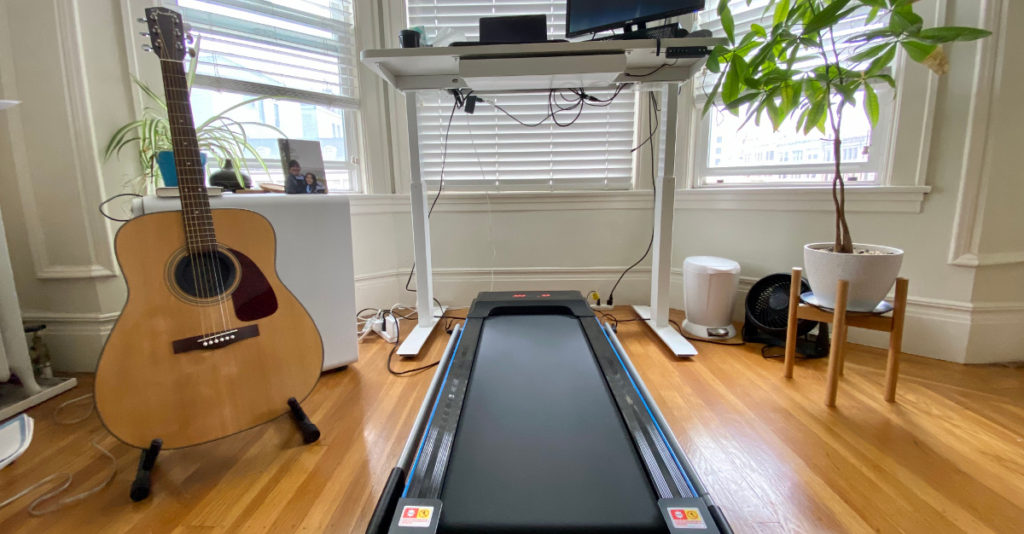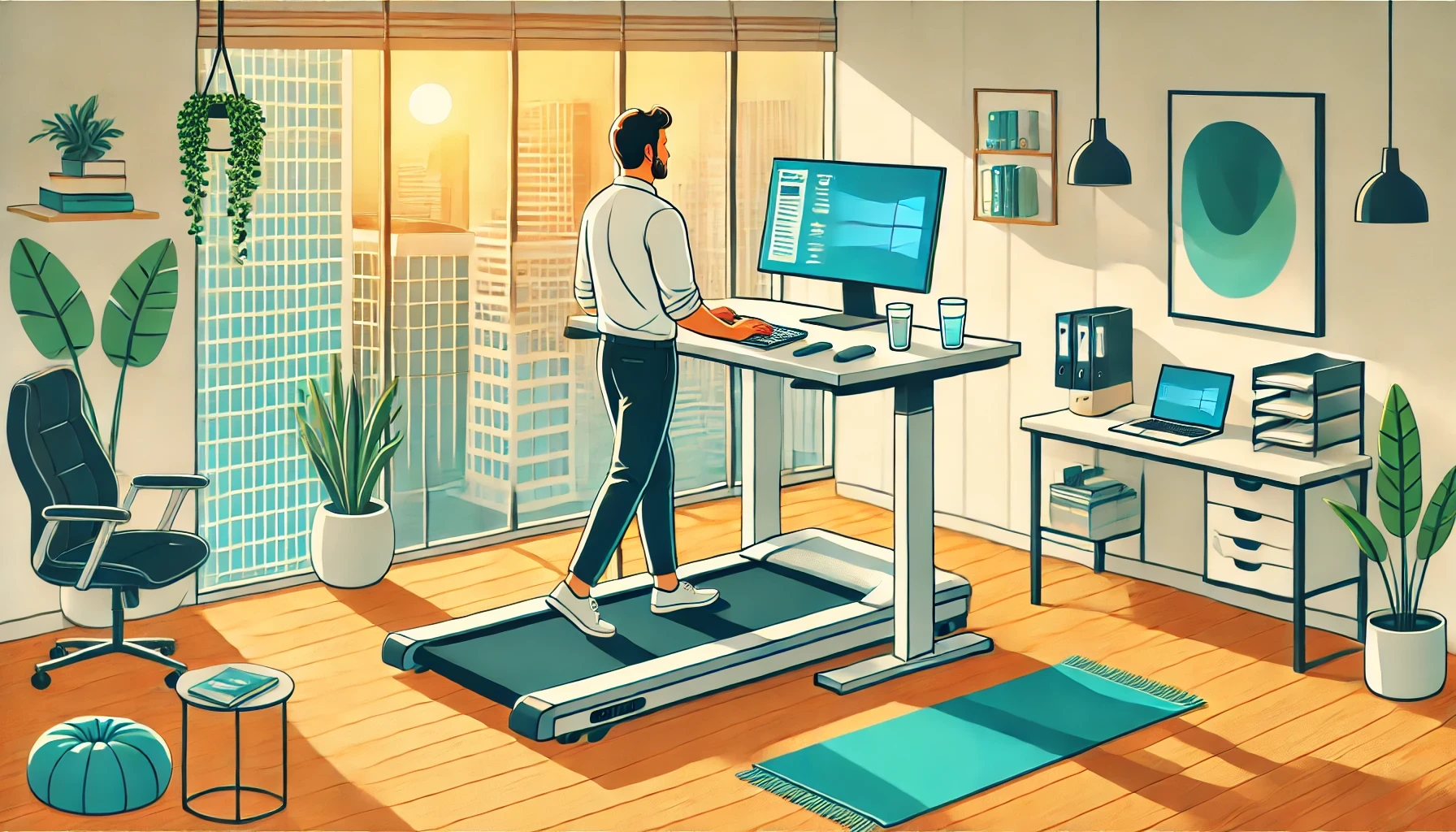Sounds like somebody’s got a case of the Mondays!
-Office Space
Ever find yourself staring blankly at your to-do list on a Monday morning, wondering where you’ll find the motivation to start your day? You’re not alone. It’s not always easy to get energized to start the workday, and even more so to maintain high energy levels throughout the day.
This post isn’t about the usual advice like getting good sleep, drinking water, or taking regular breaks (although those are important). Instead, I want to share three unconventional practices I’ve discovered that have helped me maintain consistent energy throughout the day and avoid burnout.
1. Start using a treadmill desk

What if you could improve your health, boost your energy, and enhance your work performance, all without adding extra time to your day? Enter the treadmill desk: a standing desk paired with a treadmill or walking pad that allows you to walk at a slow, steady pace while working.
Why It Works:
More Energy and Less Stress: Walking throughout the day gives me a sense of flow and energy that lasts well into the evening. My legs might feel tired, but I carry significantly less stress in my body compared to sitting all day. This reduced tension likely contributes to my overall higher energy levels.
Increased Motivation and Productivity: Walking releases dopamine, the neurotransmitter that fuels motivation. By maintaining a slow trickle of dopamine throughout the day, I find myself more engaged with work tasks. While treadmill desks aren’t suitable for every task or meeting, most knowledge workers can find at least 2-3 hours a day to use one.
Double the Steps, Extra Calories Burned: Before my treadmill desk, I averaged 8,000-10,000 steps per day. With it, I now average 20,000 steps, burning an estimated extra 500 calories daily. Over time, that’s a game-changer for both health and energy.
Pro Tip: Start with a basic walking pad to test the waters. Walking at a slow pace (e.g., 1.5-2 mph) while working may take some getting used to, but it’s worth the adjustment.
Learn more about my experiences: So I Tried a Treadmill Desk
2. Reduce Caffeine Consumption

Getting off caffeine is like turning down the heat. Everything becomes more manageable.
-Stephen Cherniske, Caffeine Blues
If you rely on caffeine to jumpstart your mornings or power through slumps, the idea of reducing or quitting may seem daunting. I felt the same way. But stepping away from caffeine brought unexpected benefits that made the transition worthwhile.
What I Learned After Reducing/Quitting Caffeine:
Freedom from Dependency: No more caffeine headaches, withdrawal fears, or obsessing over when to get my next fix. Now, my energy feels more natural and self-sustained.
Improved Sleep Quality: My Fitbit showed I was getting 30 minutes more sleep per night after quitting caffeine, with a 4-point increase in my sleep score. Better rest led to more consistent energy throughout the day.
Reduced Stress: Caffeine ramps up adrenaline, which can make everyday stressors feel overwhelming. Without caffeine, I found myself calmer and more resilient. My Heart Rate Variability (HRV), a marker of stress recovery, improved by 8% over three months.
Steadier Energy Levels: My energy no longer peaks and crashes. If I feel a slump, I tune into what my body needs, whether it’s a snack, a walk, or a short break.
Pro Tip: Not ready to quit entirely? Try reducing your intake gradually, or stick to a single morning cup to minimize withdrawal symptoms and sleep disruption.
Read about my full experiment: I Quit Caffeine for Three Months, Here’s What Happened
3. Write Down “3 Good Things” At the End of Each Day

Humans are hardwired with a negativity bias, meaning we naturally focus more on negative events than positive ones. By practicing “3 Good Things,” you can counteract this bias and build a more optimistic mindset, which translates to greater energy and resilience.
How It Works:
Each evening, write down three positive events from your day (at least one related to work). For each event, include:
- What happened
- How it made you feel
- Why it went well
Example:
- Event: I received recognition from a colleague for resolving a major program risk.
- How it made me feel: Appreciated and energized.
- Why it went well: I proactively identified the root cause and worked collaboratively with stakeholders to resolve it.
Benefits I’ve Noticed:
Greater Well-Being: This nightly practice rewires your brain to focus on the positives, boosting gratitude and overall happiness.
Increased Resilience: Even on tough days, reflecting on small wins builds a buffer against stress and negativity.
Improved Sleep: Ending the day with positive thoughts helps me unwind, resulting in deeper, more restorative sleep.
Pro Tip: Use a dedicated journal for this practice. It’s rewarding to look back and see how much good happens, even on challenging days.
Learn More about the “3 Good Things Practice”: Berkeley Greater Good In Action PDF
What About You?
Have you tried any unconventional methods to energize your workday? What’s worked (or hasn’t worked) for you? I’d love to hear your insights in the comments!
Credits
- Thank you to Joanna Chan for early draft feedback and moral support
- Feature image, caffeine free image, and “3 Good Things” image generated using DALL-E
Accelerate Your Personal Growth

Join my newsletter for more tips and bonus material.

